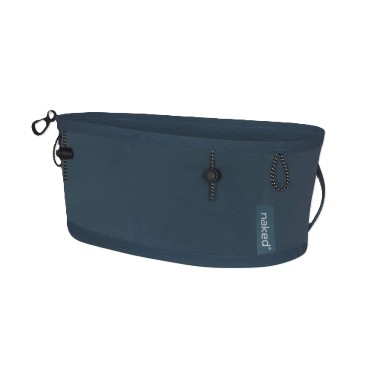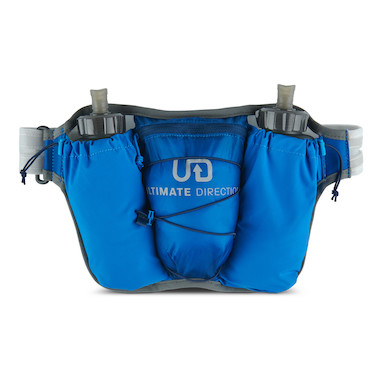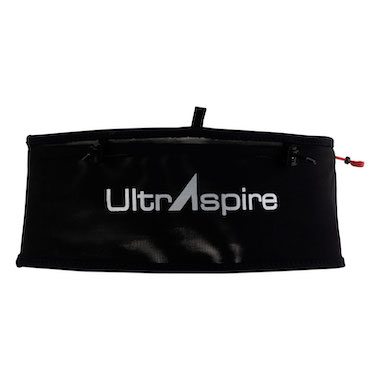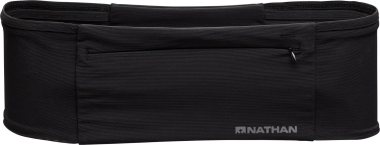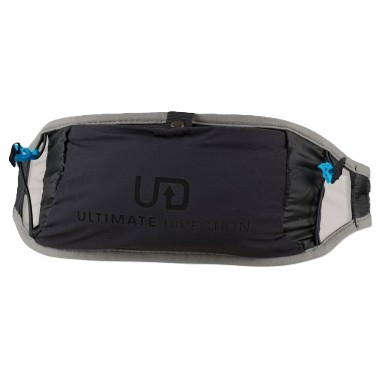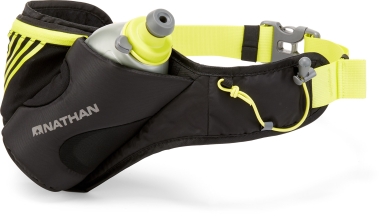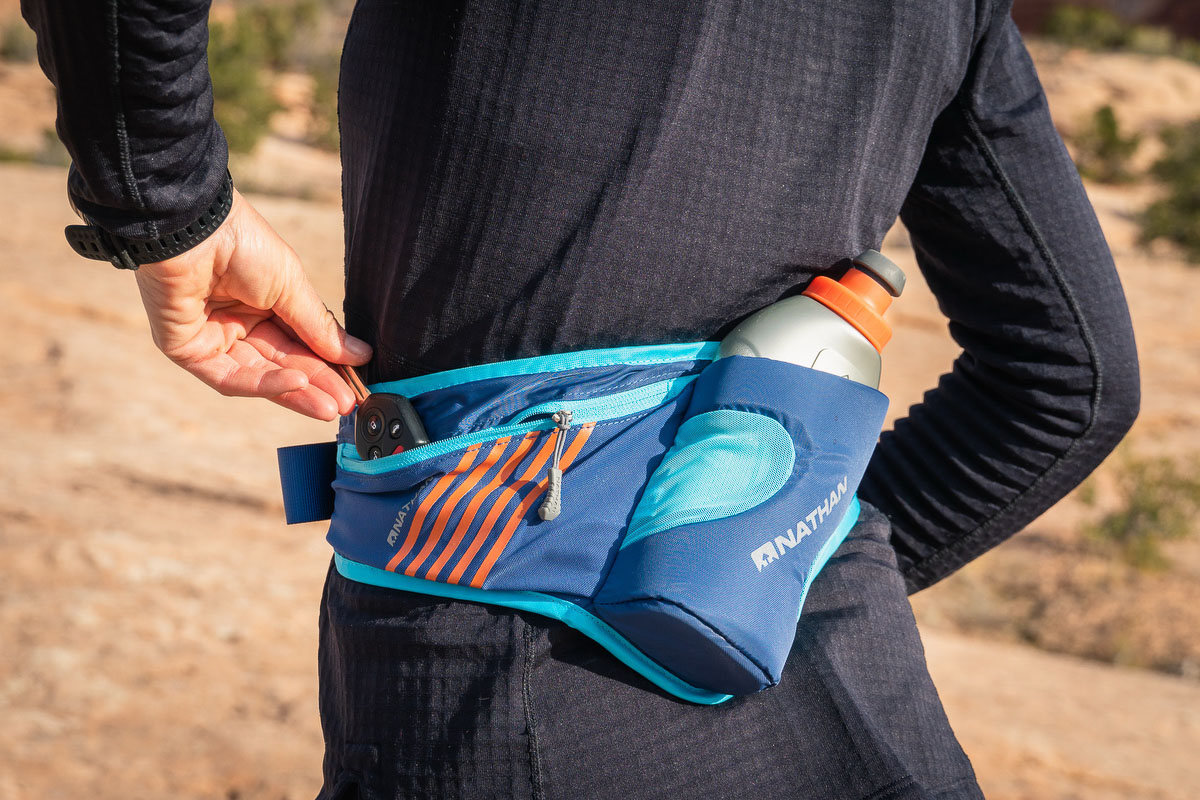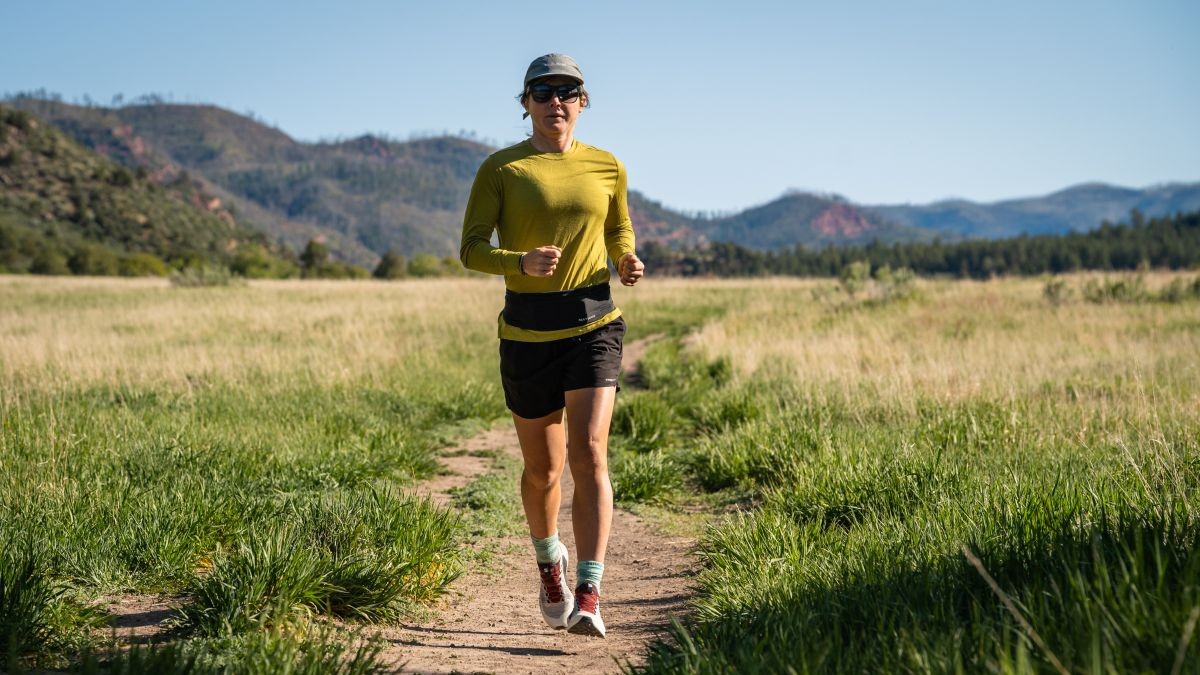
The best running belt will be comfortable and carry everything you need. Photo: iRunFar/Eszter Horanyi
Running belts and waist packs provide a convenient way to carry essential supplies and gear, including water, snacks, an extra clothing layer, your phone, keys, cards, money, and sometimes even trekking poles, all in a compact setup around your waist. The best running belt will fit comfortably around your waist or hips, remain stable when you run, and have easily accessible pockets for the items you need.
From minimalist mini-belts just big enough for a set of keys to ultramarathon-worthy running hydration waist packs that can fully substitute for a running vest, the running belt market is so large and diverse that deciding what you need can be challenging.
Our gear testing team logged hundreds of miles in the top products out there to bring you the best running belts and waist packs today. Our top picks fit into three general categories: tube-style belts, mini-belts, and larger waist packs built for carrying everything you need for an extended run. Our favorite overall running belt continues to be the Naked Running Band. When we need to carry a lot of water, we turn to the Ultimate Direction Ultra Belt, and our favorite budget pick was the UltrAspire Fitted Race Belt 2.0.
You can learn more about choosing the best running belt, find answers to frequently asked questions about running belts and waist packs, and find out about our testing methodology for this guide.
Best Running Belts
- Best Overall Running Belt: Naked Running Band
- Best High-Volume Running Belt: Ultimate Direction Ultra Belt
- Best Budget Running Belt: UltrAspire Fitted Race Belt 2.0
- Other Great Tube-Style Running Belts: Nathan Zipster Max Belt and Ultimate Direction Race Belt
- Best Hard-Side Bottle Running Belt: Nathan Peak Hydration Waist Pack
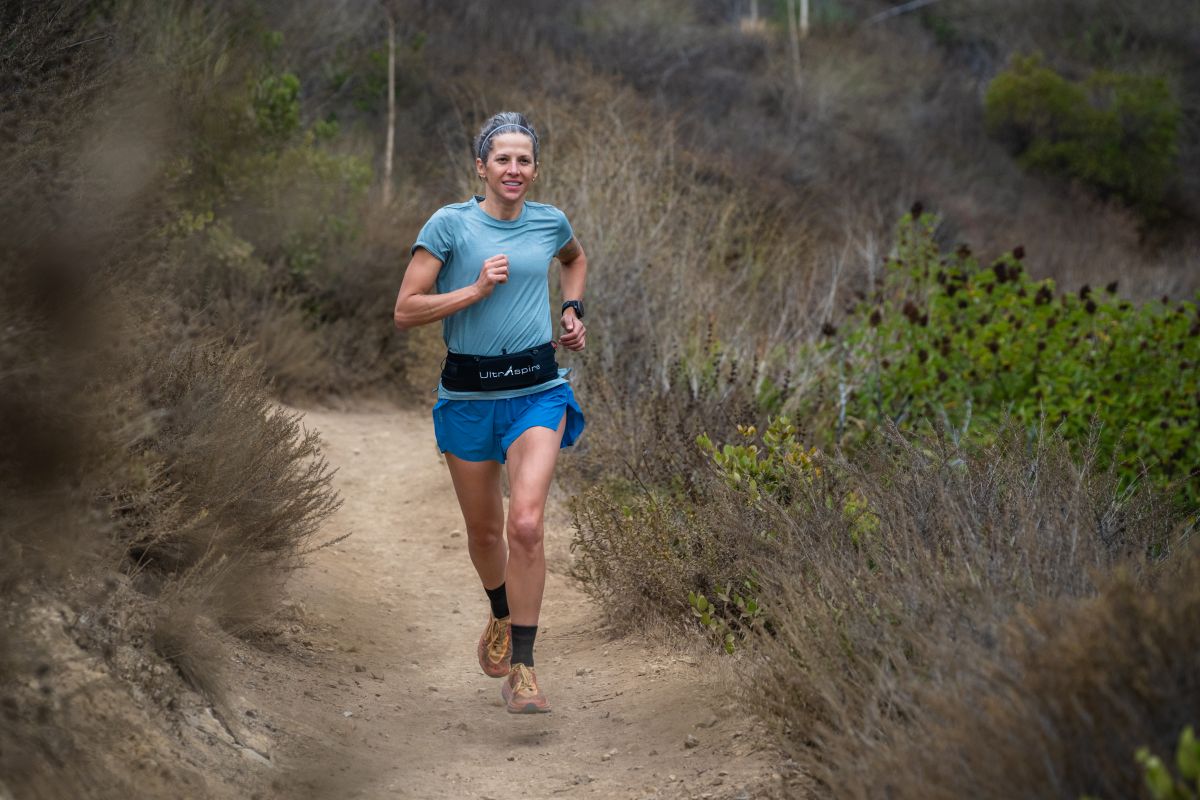
The UltrAspire Fitted Race Belt 2.0 was our top budget pick for running belts. Photo: iRunFar/Eszter Horanyi
Best Overall Running Belt: Naked Running Band ($55)
- Lots of storage
- Open pocket configuration allows you to store stuff exactly where you want to
- Stretchy and stable
Cons:
- Can feel poles on the lower back when held with bands
- Can scrunch up depending on body type
It’s been on the market for years, and many brands have tried their hand at a similar tube-style running belt, yet the Naked Running Band remains the best of its kind.
The stretchy, breathable, tube-style running waist pack has three deep pockets circling the entire belt. While this belt carries three 500-milliliter soft flasks, that amount of weight can feel cumbersome around the waist. The Naked Running Band features large elastic bands for carrying collapsible running poles on the back, which is convenient, although you may feel them in the small of your back.
These bungees can also hold a rain jacket, although a lightweight rain jacket or windbreaker could also fit snugly into the stretchy pockets. On the front of the belt, there are two bungee toggles for attaching a race bib, and there’s also an internal key clip.
This waist pack has the most precise fit of all the tube-style options, thanks to its 12 available sizes. The Naked website has a size chart, and multiple testers found the belts ran true to the advertised sizes, though one tester noted that she felt the belt that should have fit her felt too snug. Notably, some but not all testers found that the tall height of the band caused it to scrunch up slightly around the abdomen, especially when they were not carrying much inside.
Actual weight: 2.3 ounces (67 grams) | Configuration: Three large top-loading pockets encircling the belt
Shop the Naked Running BandBest High-Volume Running Belt: Ultimate Direction Ultra Belt ($80)
- Massive carrying capacity
- Doesn’t bounce as it sits low and securely on the back
Cons:
- Expensive
- Velcro catches on some clothing materials and gloves
If you’re looking for a running belt that can carry as much as a small running vest, you’ll appreciate the massive storage capacity of the Ultimate Direction Ultra Belt. While this belt is expensive, its ability to comfortably carry a lot of weight and volume makes it worth the investment for those who want to avoid using a running vest.
The belt can fit the two included 500-milliliter soft flasks at angles on the lower back in dedicated pockets with bungee closure tops. These pockets store other gear well if you’re not carrying two soft flasks.
A zippered pocket between the bottles can fit your phone, a wind jacket, snacks, and anything else you might want, though some testers stated they struggled to get the largest of phones inside when carrying two full soft flasks. Within this zippered pocket, a hidden pocket with a hook-and-loop closure allows you to securely store a key and credit cards. Finally, an adjustable bungee cord overlays the zipper pocket to hold an extra layer.
There is also a tiny pocket in the front with a Velcro closure just big enough for a key.
We took this waist pack on an all-day adventure and carried one soft flask, running fuel for seven hours, a rain jacket, gloves, a water filter, a phone, and a small headlamp. It comfortably and easily held all we would have carried in a hydration pack.
Actual weight: 5.3 ounces (150 grams) with the two included soft flasks | Configuration: Two soft flask holsters, one large zippered pocket, and one small Velcro pocket on the back; one tiny Velcro pocket on the front
Shop the Ultimate Direction Ultra BeltBest Budget Running Belt: UltrAspire Fitted Race Belt 2.0 ($33)
- Curved shape fits ergonomically on the hips
- Zippered pocket allows secure storage for keys, cards, and trash
- Best price in the tube-style running belt category
Cons:
- Can bunch up if not carrying much in the pockets
In the case of the UltrAspire Fitted Race Belt 2.0, a lower price doesn’t equate with fewer features or compromised performance. This tube-style running belt has a shape that’s taller in the front and shorter in the back, thanks to curves on the bottom edge of the waist pack. This distributes pressure across a wider area on the abdomen and minimizes the chance of bunching around the back.
This belt has three large pockets that can hold your phone, hydration, nutrition, and anything else you may want to carry. One of the pockets closes with a vertical zipper. While the zipper will keep your keys or whatever else you put in the pocket secure when zipped, its verticality increases the chance of losing an item if you forget to zip it. The other two pockets are open at the top, making it easy to slip items in and out.
Bungee cords on the back securely carry your poles or an extra layer of clothing, and the largest pocket on the front will comfortably hold a full-size soft flask. If you wear this belt in a race, there are two bungee toggles to attach to your bib. While this is an excellent design for an everyday running belt and offers great value, some testers noticed that it bunched up if they weren’t carrying much.
Actual weight: 2.4 ounces (68 grams) | Configuration: Two large top-loading pockets and one pocket with a vertical zipper
Shop the UltrAspire Fitted Race Belt 2.0Other Great Tube-Style Running Belts
Nathan Zipster Max Waistbelt ($45)
- Excellent fit
- Good storage capacity
- Dries quickly
Cons:
- Doesn’t carry more than one flask easily
The Nathan Zipster Max Waistbelt is the brand’s widest-fitted minimalist running belt. Our tester described it as “the perfect running belt,” as it boasts many crucial features. First, and perhaps most importantly, the fit is spot-on. The Zipster stays securely in place with no bounce but is not overly tight and seems to have the right amount of stretch.
We took this out on many long runs while marathon training, sometimes holding a phone, car key, sunglasses, gels, headphones, and gloves, and we were impressed with how still this belt stayed on our waist, even when fully loaded. We were also impressed by the belt’s ability to dry quickly during a few runs in the rain, and the two water-resistant pockets kept our phone and key fob dry, so we didn’t need to carry an extra plastic bag for them when we got caught out in a light sprinkle. However, we can’t say how long they would keep items dry in a downpour. The front and side pockets are big enough to hold a flask, though we probably wouldn’t recommend carrying more than a single soft flask with this belt.
As far as pockets go, there is one on each side, one extra-large zippered water-resistant pocket on the front, and one small zippered water-resistant pocket on the back. After a few months of testing and multiple long runs, the belt continues to hold its shape and fit correctly. This lightweight mesh running belt comes in six sizes, and we had no issues with it scrunching up on our abdomens.
Actual weight: 2.1 ounces (60 grams) | Configuration: Two side pockets, one extra-large zippered water-resistant pocket, and one small zippered water-resistant pocket
Shop the Nathan Zipster Max Waistbelt
Ultimate Direction Race Belt ($60)
- Super easy to access and stow the included soft flask
- No hanging straps, thanks to Velcro closure
- No bounce and a very comfortable ride
Cons:
- Velcro catches on some clothing materials and gloves
The Ultimate Direction Race Belt is a smaller running waist pack perfect for carrying a full-sized soft flask. This belt closes in the front with a Velcro layover rather than a buckle clasp, meaning there’s no extra strap material dangling in the wind. The system allows for plenty of adjustability, making this one-size-fits-all waist pack versatile.
This waist pack has three pockets — a tiny pocket on the front right side to hold a key and two pockets on the back. The main back pocket carries a soft flask that loads from the top and has a snap closure, and the internal zipper pocket securely holds your phone or other items. The internal zipper pocket also has a key clip.
Finally, adjustable bungee cords on the back allow you to attach poles or an extra layer. Even with a full soft flask, the poles attach easily and comfortably.
Unlike other waist packs, where the soft flask can stretch the mesh or bounce around, the Ultimate Direction Race Belt design ensures that the soft flask in the back sits securely, slides in and out easily, and doesn’t bounce. Handling soft flasks can be a wiggly experience, and this belt offers a streamlined solution. On that note, this waist pack comes with one Ultimate Direction Body Bottle 500-milliliter soft flask.
Actual weight: 2.0 ounces without the included soft flask (57 grams) | Configuration: One large top-loading pocket and one zippered pocket on the back; one tiny Velcro pocket on the front
Shop the Ultimate Direction Race BeltBest Hard-Sided Bottle Belt: Nathan Peak Hydration Waist Pack ($44)
- Carries a hard-sided water bottle better than any other waist pack we tested
- Included water bottle slips in and out easily
- No bounce
Cons:
- Limited storage beyond carrying water
- Doesn’t come in multiple sizes to accommodate the widest array of body types
- No key clip
If you prefer to drink out of a hard-sided bottle rather than a soft flask, the Nathan Peak Hydration Waist Pack sits at the top of our list. The included hard-sided Nathan Speed Draw Flask with the push/pull Race Cap holds 18 ounces (535 milliliters) of liquid, which is a bit more than most soft flasks. It’s a good amout for races with frequent aid stations or city runs where you pass by water fountains occasionally. The bottle is easy to fill and drink out of.
The included flask is ergonomically shaped and flat on one side, allowing it to sit nicely against the small of your back. Its curved sides and bump on the outer face make it comfortable for hands of many sizes to hold. Finally, pulling out and replacing the flask in its designated holster while running feels easy and smooth.
This pack offers just one zippered pocket that wraps around the left back side for storage. It’s big enough for your phone, key, and a couple of snacks. To the right side of the water bottle holster is an adjustable bungee cord that allows you to stow a small jacket, hat, or gloves. Overall, the storage is pretty minimal.
This running belt has no bounce — none at all — courtesy of its wide webbing and overall shape that fills much of the surface area of the small of your back. One of our testers even found the wide webbing to be overkill for this small pack, though others appreciated it for its stability.
This single-size belt connects at the front with a buckle and adjusts to fit most body sizes. And in case you’re wondering, a few other hard-sided water bottles do fit into this waist pack, but not with the precision fit of the included Nathan Speed Draw Flask.
Actual weight: 6.3 ounces with the included hard-sided water bottle (178 grams) | Configuration: Water bottle holster and one zippered pocket on the back
Shop the Nathan Peak Hydration Waist PackComparing the Best Running Belts
| NAME | PRICE | WEIGHT | CAPACITY |
| Naked Running Band | $55 | 2.3 ounces | 2+ liters |
| Ultimate Direction Ultra Belt | $80 | 5.3 ounces | 2.9 liters |
| UltrAspire Fitted Race Belt 2.0 | $33 | 2.4 ounces | 0.74 liters |
| Nathan Zipster Max Waistbelt | $44 | 2.1 ounces | 1.5 liters |
| Ultimate Direction Race Belt | $60 | 2.0 ounces | 1 liter |
| Nathan Peak Hydration Waist Pack | $44 | 6.3 ounces | 0.65 liters |
Buyer’s Guide: How to Choose a Running Belt
Various Styles of Running Belts
The best running belts and waist packs generally fall into three categories:
- Tube-style belts: Ultralight, minimalistic, and adaptable
- Mini-belts: Small and meant only to hold your keys, card, and phone
- Larger waist packs built around carrying specific water bottles: Besides hydration, these can additionally hold snacks, extra layers, poles, and more
The best running belt for you will depend on the type of run you’re going on. For a quick three miles around the block with shorts that don’t have pockets to carry your keys, a low-capacity belt will do the trick. A trail marathon with numerous aid stations for refilling water bottles or a remote, high-altitude adventure where you’re primarily self-reliant will each warrant a different style of running belt. If you need more storage than a waist belt can handle, check our Best Running Vests guide for additional options.
The style you use is also a matter of personal preference and comfort. For example, the best running belt for a minimalist differs from someone who loves to drink out of hard-sided water bottles and would thrive with the Nathan Peak Hydration Waist Pack. Whatever you desire, this guide has a waist pack for you.
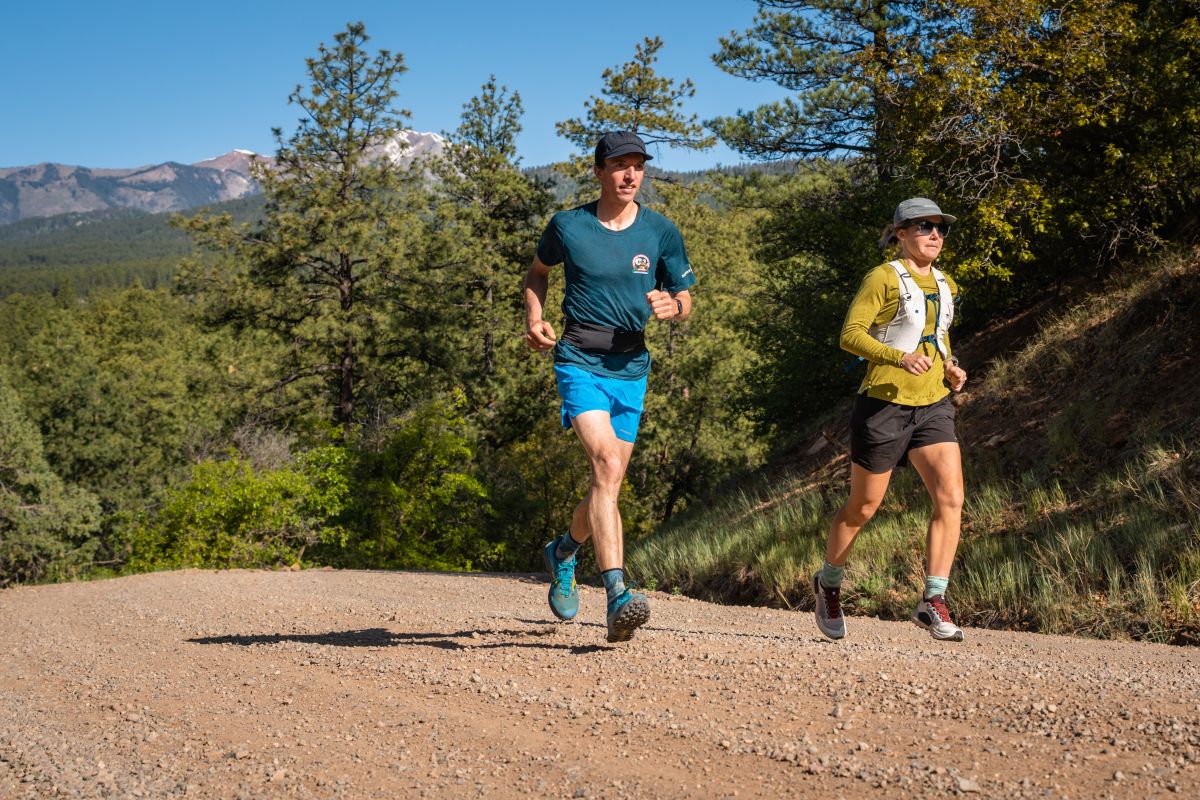
Running belts are a way to carry what you need on your run if you don’t want to wear a full vest. Photo: iRunFar/Eszter Horanyi
Fit
Many people choose running belts and waist packs instead of vests because they place more weight on the hips and waist rather than the shoulders. This lowers your overall center of gravity, and some feel like this makes them more stable compared to carrying weight high on their back in a hydration vest. Belts also reduce chest and back coverage, which can minimize sweat buildup on your shirt, while also making you feel cooler.
Each runner’s body type will partly dictate the best running belt for them. The right belt or waist pack will sit snugly around the body without being too tight, riding up, or falling down while moving. Some brands do this better than others, and a style that works for one person may not work for another.
We’ve found that men and women wear waist belts differently. Men have a much straighter line from the waist to the hips, and women tend to taper at the waist. As a result, men tend to wear waist belts at their natural hips, and women tend to want them higher up and closer to their waists.
It’s always best to try on a waist belt before purchasing to ensure you get the correct size. When buying online, follow each brand’s sizing chart and instructions carefully. Many of the belts in this guide, like the Ultimate Direction Race Belt, are one-size-fits-most and have a good level of adjustment. Meanwhile, the Naked Running Band, a tube-style waist belt, offers 12 different size options with a step-by-step guide for choosing the right one for you.
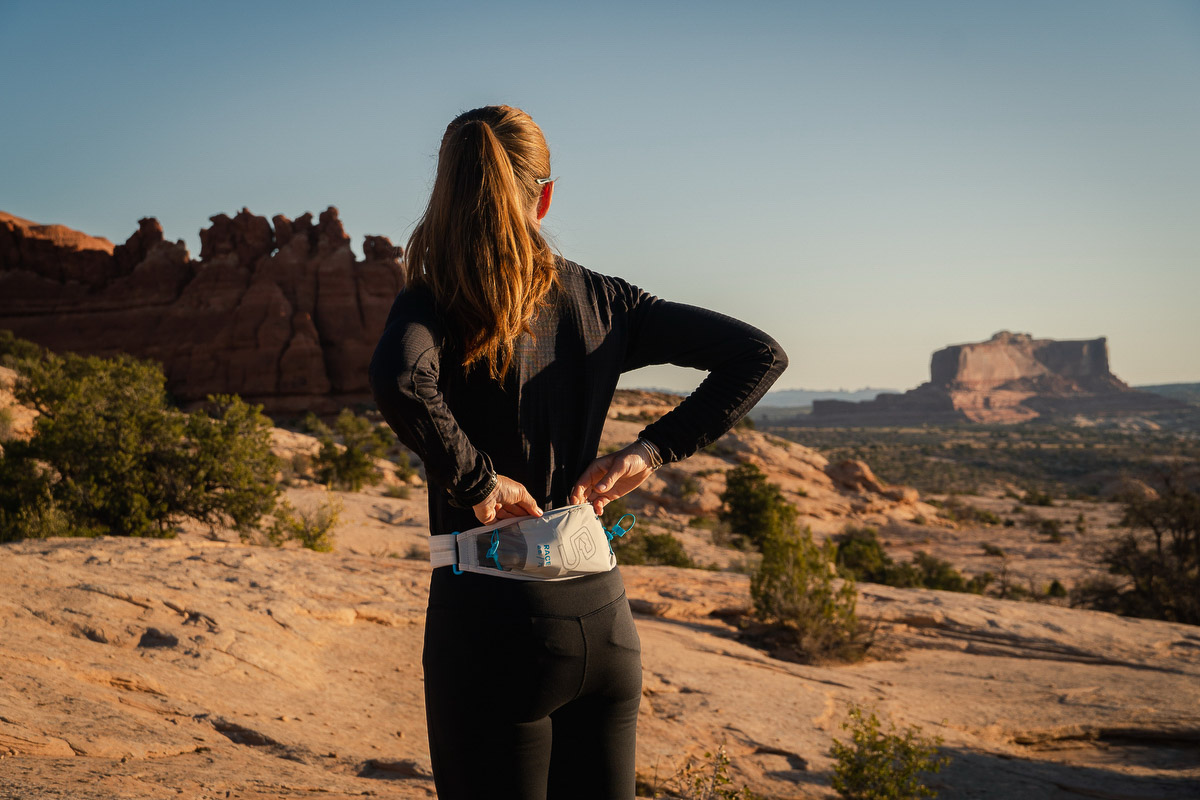
iRunFar Editor-in-Chief Meghan Hicks tests the Ultimate Direction Race Belt on a run outside Moab, Utah. Photo: iRunFar/Eszter Horanyi
Storage and Size
Even within the three categories of running belts, there are a variety of storage capacities among different designs and styles. The best running belt for you may be a simple tube-style belt that holds water and a few essentials, such as the Naked Running Band. If you want to carry a lot of stuff, you might turn to a maximal waist pack, like the Ultimate Direction Ultra Belt. Or, you may prefer a wider belt that feels better on your abdomen than a thin one, even though you’re not carrying as much. The UltrAspire Fitted Race Belt 2.0 is thicker around the front than the back to reduce pressure on the abdomen.
You may also consider how easy it is to access the items you are storing: Are there zipper pockets, magnetic closures, or fabric overlays? Do the things you’re carrying feel solid and secure while running? Part of the beauty of waist belts is their convenience, and you want it to be easy to access your water or nutrition.
Sweat Factor
Like other running gear, we look for running belts and waist packs with good wicking ability and breathability. Running belts are a great alternative to running vests if you’re a heavy sweater and want to keep your back and chest area as dry as possible.
Belts can help with thermoregulation and reduce overheating when the temperatures rise. A running belt that breathes well will also minimize the chance of chafing. A pack like the Ultimate Direction Ultra Belt will hold almost as much as a small running vest and may work better for warm-weather training and racing than a traditional vest for some people.
Stomach Comfort
A waist belt may not be the right solution for individuals who are sensitive to pressure or materials around their stomachs while running. If you’re concerned about pressure, consider a running belt like the Naked Running Band, which comes in various sizes and has a good amount of stretch. You might also consider one with an adjustable strap, such as the Nathan Peak Hydration Waist Pack.
We found that all the running belts we included in this guide stayed securely in place without being too tight. The UltrAspire Fitted Race Belt 2.0 is wider around the front than the back to reduce pressure on the abdomen while still keeping the pack in place.
Cost
While there is truth in the adage you get what you pay for, you don’t have to break the bank for a quality running belt. A belt with significant storage, like the Ultimate Direction Ultra Belt, will naturally cost more, but you should also consider it compared to the price of a running vest. Our top budget pick, the UltrAspire Fitted Race Belt 2.0, represents a tremendous value. At $33, it’s a comfortable belt with ample storage for most runs.

The back pocket of the former CamelBak Ultra Belt 17oz easily held a 500-milliliter soft flask and has bungee loops to hold poles. Photo: iRunFar/Eszter Horanyi
Why You Should Trust Us
iRunFar’s robust testing process ensures you get the best gear for your needs. We consider quality, durability, cost, and a host of other elements when choosing which models of gear to test and include in this guide.
For the initial version of this guide, we extensively researched the running belts and waist packs on the market before choosing roughly 20 top candidates for extensive testing in our first iteration of this guide. We then tested the products on mountains and singletrack through rocks, mud, rain, and a few genuinely epic storms throughout all four seasons to determine which ones performed the best in various conditions.
Over the years since we first published this guide, our gear team has continued testing running belts through the same rigorous process and updating our favorites. We also often keep using our top picks in our daily running, allowing us to speak to their durability and longevity over the years.
Frequently Asked Questions About Running Belts and Waist Packs
What’s the difference between a running belt, waist pack, and waist belt?
Not a whole lot! These terms are generally used interchangeably by brands marketing their products. All of the names refer to a piece of gear worn around the waist with pockets and holsters for storing water and gear. For ease, we also use these phrases interchangeably in this guide. While the Nathan Peak Hydration Waist Pack and the Ultimate Direction Ultra Belt use different terminology, in the end, they are essentially the same style of product with various features.
Why would I use a running belt or waist pack instead of a hydration vest?
In general, it comes down to the length of your run, what you need to carry, and personal preference. If all you’re carrying is a phone and a set of keys, and you’re going on a shorter run, you most likely don’t need more than a minimal waist pack. In these scenarios, carrying a full running vest is overkill, but it’s still nice to have your hands free and not have to keep track of multiple items.
Running belts are also great if you don’t want your back to get sweaty. A larger waist pack, like the Ultimate Direction Ultra Belt, can carry nearly as much as a regular hydration vest, but since it sits around the hips and doesn’t cover your back and part of your chest, your shirt will get less sweaty. This can also help overall thermoregulation and may be a solid option for warmer-weather runs. Some people also like running belts because they allow you to carry weight lower on your body. Unfortunately, running belts can put extra pressure on the abdomen, which can get uncomfortable, especially when racing ultras where nearly everyone experiences some level of stomach discomfort.
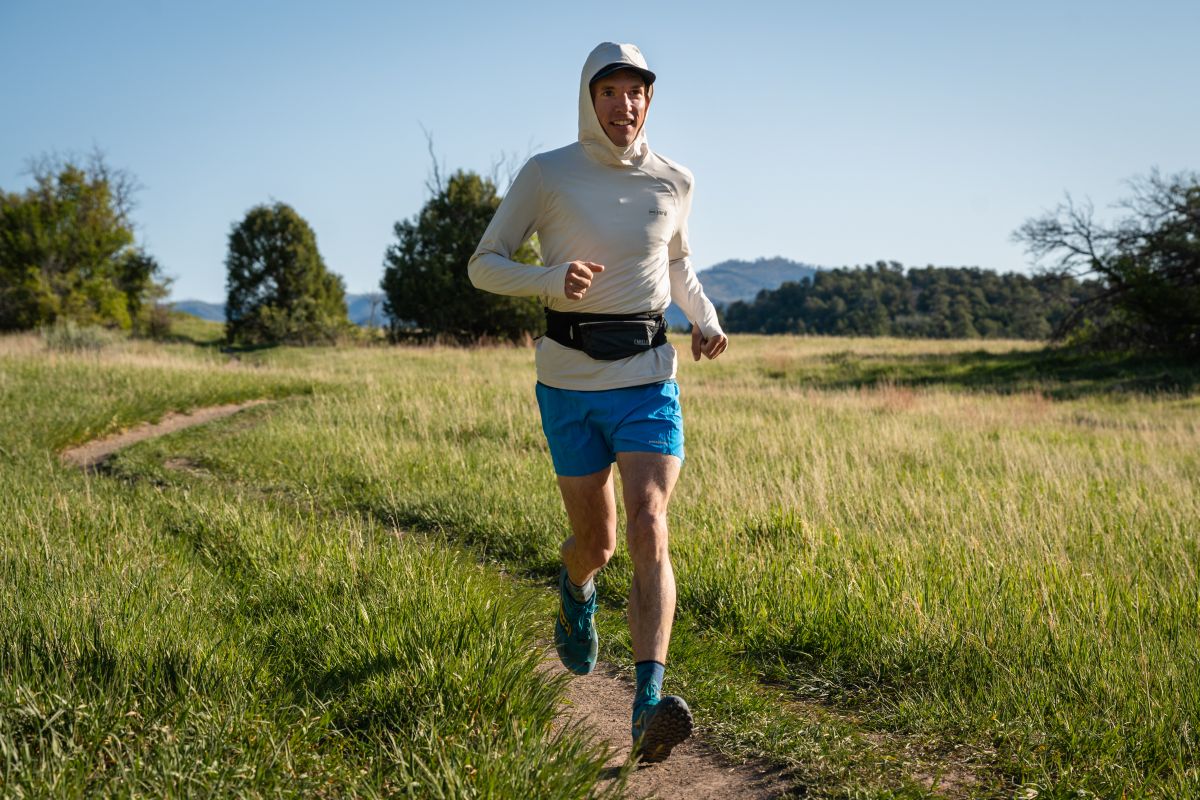
The discontinued CamelBak Ultra Belt 17oz had a large front zippered pocket to securely hold essentials. Photo: iRunFar/Eszter Horanyi
Why should I use a running belt instead of pockets on my running shorts or tights?
In reality, many running shorts or tights can store small items either in pockets on the sides or around the waist. It ultimately comes down to a matter of personal preference and what feels most comfortable for you. If you want to skip the belt and carry items in your shorts, you can check out our favorite options in our Best Running Shorts for Men and Best Running Shorts for Women guides. Products in our Best Women’s Running Tights and Best Running Tights for Men guides also have storage options.
We can say, after testing many shorts and tights over the years, that few garments hold more than your keys and phone without issue. A running belt opens up the opportunity to carry a little more, such as water. Even a minimalist belt will hold the essentials for a short run, but a slightly larger belt, like our favorite, the Naked Running Band, can carry pretty much everything you need for most runs up to a few hours.
What’s the best running belt?
The best running belt, of course, is the one that meets your needs. It should be comfortable, fit well, and carry what you’d like to take on your runs. For ultrarunners who need to carry many hours’ worth of gear and fuel, that might mean a high-storage belt like the Ultimate Direction Ultra Belt. Others going out for shorter runs will likely prefer something with less storage, like the Nathan Peak Hydration Waist Pack. We appreciated the simple design, comfort, and versatility of the Naked Running Band.
How much water can I carry in a running belt?
Different running belts can carry anything from a single soft flask to well over a liter of water. Some, like the Ultimate Direction Race Belt, will carry water in soft flasks, while others, like the Nathan Peak Hydration Waist Pack are specifically designed for hard-sided water bottles.
If you need more water in soft flasks, the Ultimate Direction Ultra Belt is a great option.
What else can I carry in a running belt or waist pack?
You can carry anything you want. The standard is keys, running fuel, a phone, and maybe hydration. For belts with a larger carrying capacity, like the Ultimate Direction Ultra Belt, you can add an extra layer, enough calories for a couple of hours on the trail, and even trekking poles. You can learn more about poles that will fit on a running belt in our Best Trekking Poles guide.
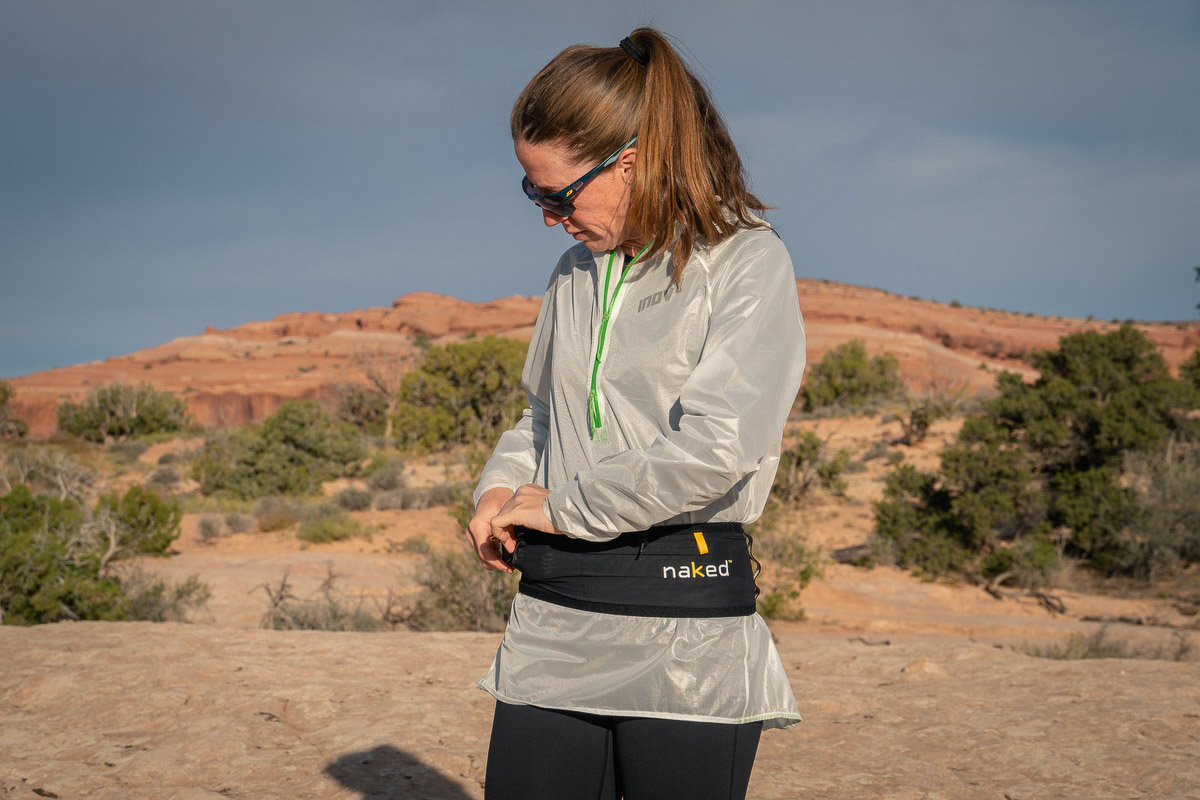
The Naked Running Band holds everything we needed during a run in the high desert. Photo: iRunFar/Eszter Horanyi
How do I keep my stomach comfortable while wearing a running belt?
Some people don’t mind the slight compressive feeling around the middle created by a running belt, while others hate any pressure over the abdomen. If you’re in the second camp and still want to find the best running belt for short runs, choose one that stretches very easily, like the Naked Running Band.
If possible, we recommend trying out a few different sizes to see what feels best for you. If you’re wearing an adjustable belt, wear it as loosely as possible while making sure it’s snug enough to not bounce around. The UltrAspire Fitted Race Belt 2.0 is a bit wider around the front than the back, reducing pressure on the abdomen while allowing for a snug and bunching-free fit.
An alternative is adjusting where you wear the pack on your body. Wearing a belt around the hips instead of the waist can reduce pressure on the stomach.
It’s worth noting that there are running belts on the market that don’t have enough stretch to fit around women’s wider hips in a size that would be appropriate for their waist, and we recomment trying on a running belt before purchase whenever possible.
Call for Comments
- Do you prefer to wear a running belt or vest to carry your gear and nutrition on runs?
- What’s your favorite running belt, and what features do you love about it?
